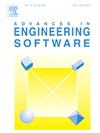On the effectiveness of multigrid preconditioned iterative methods for large-scale frequency response topology optimization problems
IF 5.7
2区 工程技术
Q2 COMPUTER SCIENCE, INTERDISCIPLINARY APPLICATIONS
引用次数: 0
Abstract
Large-scale static topology optimization of mechanical structures has been successfully realized for linear problems, including giga-voxel resolution aircraft wings and suspension bridges. Wherein the multigrid preconditioned conjugate gradient method (MG-CG) plays an important role in the repetitive solution of the state equations. However, research on large-scale dynamic topology optimization, e.g., frequency response problems, is still limited. Since the coefficient matrix of the dynamic equation is no longer a positive definite symmetric matrix, yet an indefinite, non-Hermitian and complex matrix, the conjugate gradient method (CG) is no longer applicable and the standard weapon-of-choice, the geometric multigrid preconditioner is no longer guaranteed to work. It is therefore of interest to investigate which iterative methods, if any, posses excellent generality and low computational-cost. In this paper, the effectiveness of several typical preconditioned iterative methods is studied, including conjugate gradient method, biconjugate gradient stabilized method (BICGSTAB), induced dimensionality reduction (IDR), generalized minimum residual method (GMRES). A detailed comparison and analysis of iterative methods' convergence, mesh dependence, and sensitivity to stiffness distribution in dealing with indefinite problems is given first. Then, despite its known disabilities, the geometric multigrid method is applied as a preconditioner for GMRES, BICGSTAB and IDR, i.e., MG-GMRES, MG-BICGSTAB and MG-IDR, to facilitate the efficient solution of large-scale frequency response analysis. In addition, the influence of several smoothers, including damped Jacobian iteration, successive over relaxation, symmetric SOR, and incomplete LU factorization, on the convergence of geometric multigrid iterative methods is also discussed. Numerical examples show that MG-BICGSTAB deals with low-frequency problems well, but for the whole frequency range, MG-GMRES with ILU smoother converges quickly and steadily, even if the model is extremely large. Furthermore, the effectiveness of the proposed procedure is further verified in dynamic topology optimization with up to 2.8 million degrees of freedom using a standard desktop computer.
多网格预处理迭代法求解大规模频响拓扑优化问题的有效性研究
机械结构的大规模静态拓扑优化已经成功地实现了线性问题,包括千兆体素分辨率的飞机机翼和悬索桥。其中,多网格预条件共轭梯度法(MG-CG)在状态方程的重复求解中起着重要作用。然而,对频率响应等大规模动态拓扑优化问题的研究仍然有限。由于动力方程的系数矩阵不再是正定对称矩阵,而是不定的非厄米复矩阵,因此共轭梯度法(CG)不再适用,几何多网格预调节器也不再保证起作用。因此,研究哪些迭代方法(如果有的话)具有良好的通用性和较低的计算成本是有意义的。本文研究了几种典型的预条件迭代方法的有效性,包括共轭梯度法、双共轭梯度稳定法、诱导降维法、广义最小残差法。首先对求解不确定问题的迭代方法的收敛性、网格依赖性和对刚度分布的敏感性进行了详细的比较和分析。然后,尽管存在已知的缺陷,将几何多重网格方法作为GMRES、BICGSTAB和IDR的前置条件,即MG-GMRES、MG-BICGSTAB和MG-IDR,以促进大规模频响分析的有效求解。此外,还讨论了阻尼雅可比迭代、逐次过松弛、对称SOR和不完全LU分解等平滑项对几何多网格迭代方法收敛性的影响。数值算例表明,MG-BICGSTAB可以很好地处理低频问题,但对于整个频率范围,即使模型非常大,具有ILU平滑的MG-GMRES也可以快速稳定地收敛。此外,在标准台式计算机上,进一步验证了该方法在高达280万自由度的动态拓扑优化中的有效性。
本文章由计算机程序翻译,如有差异,请以英文原文为准。
求助全文
约1分钟内获得全文
求助全文
来源期刊

Advances in Engineering Software
工程技术-计算机:跨学科应用
CiteScore
7.70
自引率
4.20%
发文量
169
审稿时长
37 days
期刊介绍:
The objective of this journal is to communicate recent and projected advances in computer-based engineering techniques. The fields covered include mechanical, aerospace, civil and environmental engineering, with an emphasis on research and development leading to practical problem-solving.
The scope of the journal includes:
• Innovative computational strategies and numerical algorithms for large-scale engineering problems
• Analysis and simulation techniques and systems
• Model and mesh generation
• Control of the accuracy, stability and efficiency of computational process
• Exploitation of new computing environments (eg distributed hetergeneous and collaborative computing)
• Advanced visualization techniques, virtual environments and prototyping
• Applications of AI, knowledge-based systems, computational intelligence, including fuzzy logic, neural networks and evolutionary computations
• Application of object-oriented technology to engineering problems
• Intelligent human computer interfaces
• Design automation, multidisciplinary design and optimization
• CAD, CAE and integrated process and product development systems
• Quality and reliability.
 求助内容:
求助内容: 应助结果提醒方式:
应助结果提醒方式:


